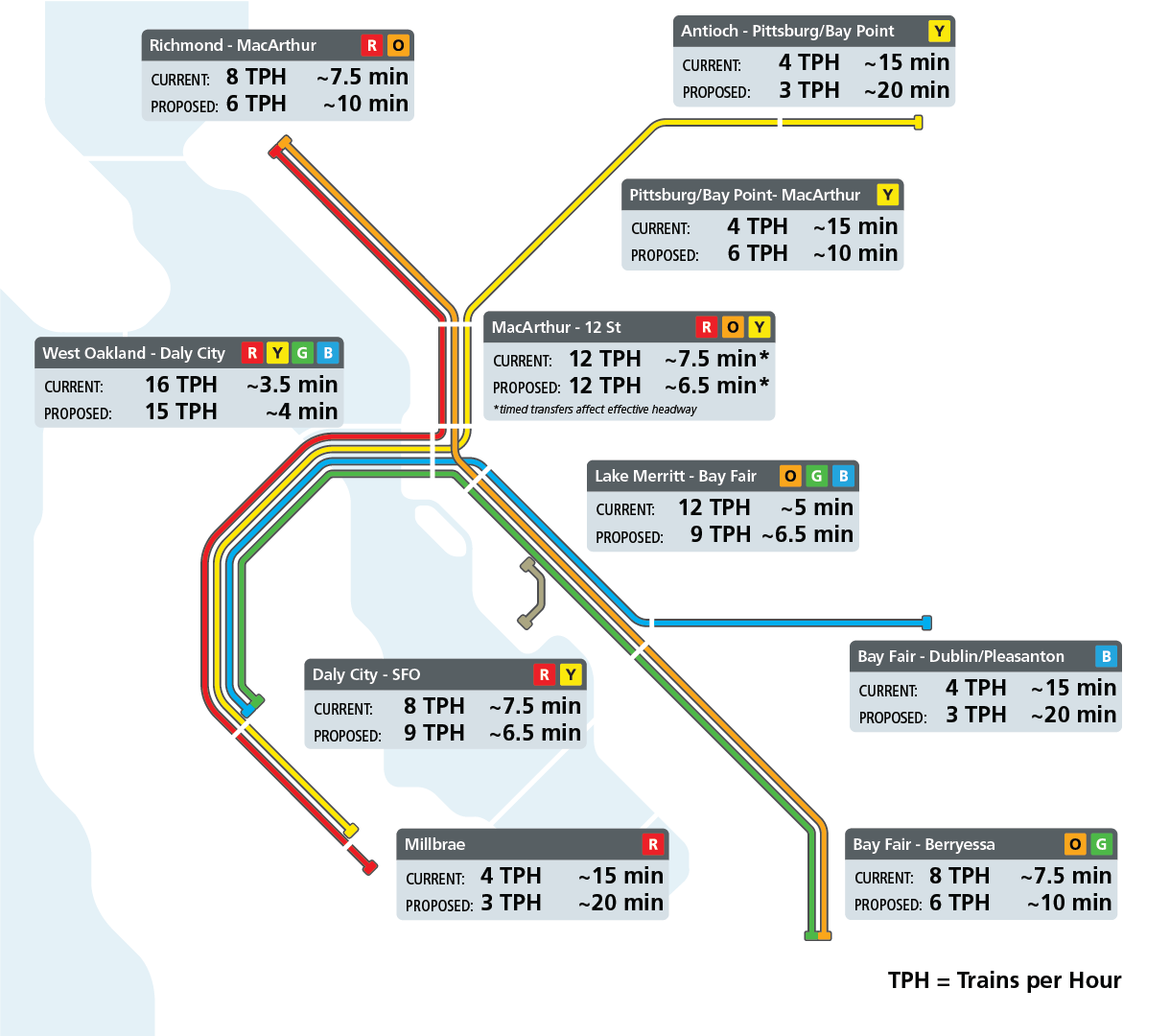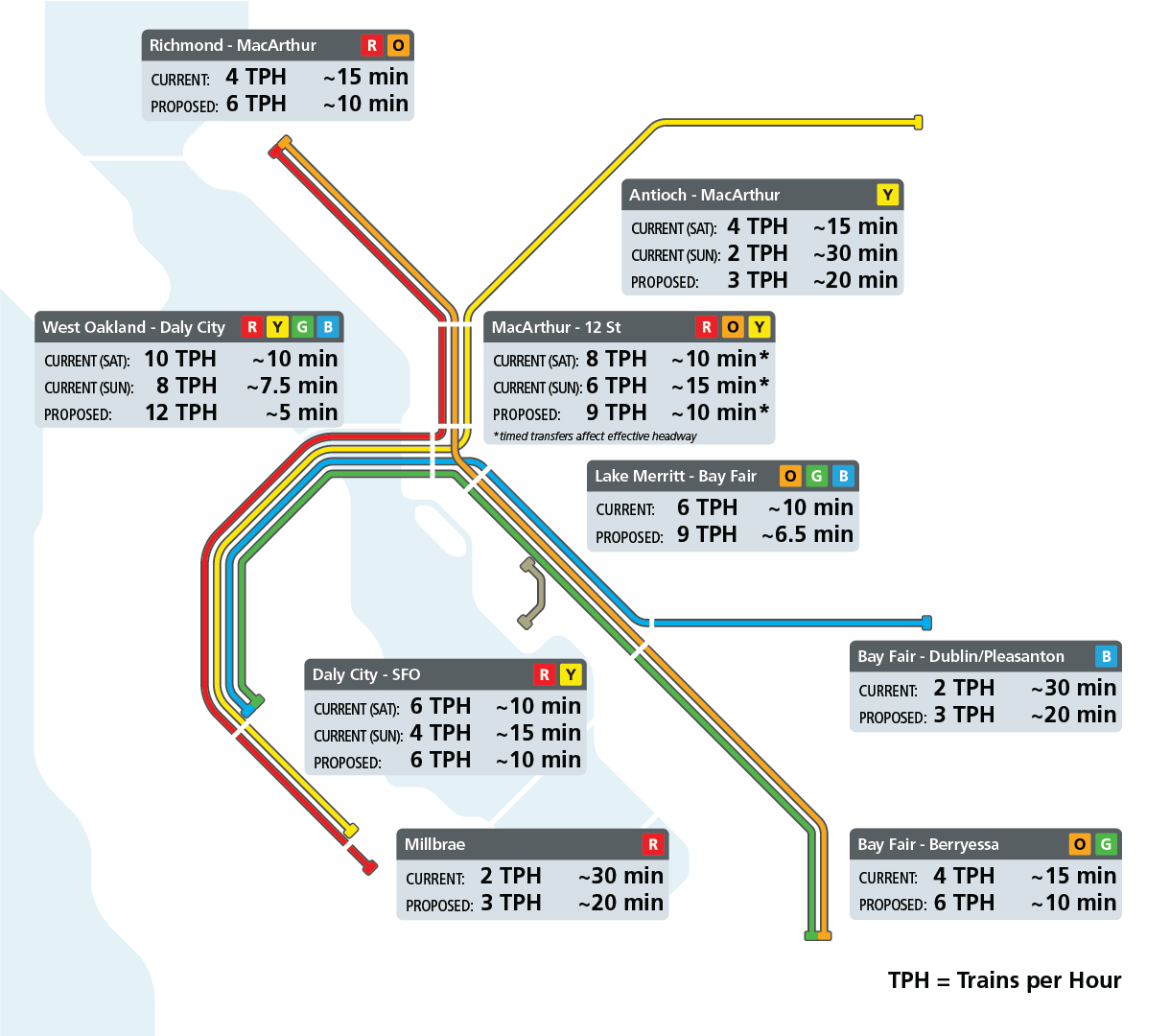Search Results
Take BART to Oakland Pride Sat. 8/31
Join BART this Sunday, August 31, for Oakland Pride parade and festival. The parade begins at 10:30 am at 14th and Broadway and ends at Broadway and 20th. The festival opens at 11 am. Look for the BART booth and BARTmobile. We'll have extra personnel at our downtown Oakland stations and the first trains on
Rebuilding the backbone of BART is improving the rider experience
The latest progress of the Measure RR rebuilding program is making a difference for riders by enhancing the reliability of the system and reducing service delays. The number of trains delayed due to outdated rail fell by more than 400 instances thanks to work that in some cases replaced track that had been in place since the start of BART service in 1972.
The reduction in service delays is among the findings in the latest Measure RR Annual Report published by the Bond Oversight Committee (BOC). The BOC’s independent oversight of the rebuilding program emphasizes cost-effectiveness, quality, and timeliness of work completion. The new annual report will be presented to the BART Board of Directors at its meeting on Thursday, July 11.
“Measure RR is a crucial part of our ongoing efforts to ensure BART is truly the safest way to get around the Bay,” said BART General Manager Bob Powers. “This Measure RR Annual Report highlights how the rebuilding program is boosting safety, making our core infrastructure more resilient, and improving our on-time performance for our riders.”
Through March 2024, $1.81 billion of Measure RR funds have been invested in rebuilding projects. There are now 157 projects in planning, design, construction, or have been completed. A total of 61 projects are complete, including 13 projects that have been completed since the BOC issued its last annual report in 2023. Measure RR money spent, and work completed to this point, have exceeded initial expectations.
Much of this progress for riders has been accomplished during weekend track shutdowns, when crews temporarily close a portion of the trackway to expedite track work that’s too large to accomplish during the few overnight hours when BART is not running trains. An example of this work is the ongoing effort to rebuild the core of the system in Oakland. You can learn more about the project and upcoming work dates here.
Measure RR is a $3.5 billion bond measure to replace BART’s aging infrastructure. It was approved by voters in Alameda, Contra Costa, and San Francisco counties in 2016.
BOC members review projects and data presented by BART staff in quarterly briefings. Members of the committee can request additional documents, information, and presentations on an ad hoc basis. The BOC is comprised of volunteers who represent a diversity of expertise. The organizations represented on the committee include the Institute of Electrical and Electronic Engineers, the American Institute of Certified Public Accountants, the Association for Budgeting and Financial Management, the Project Management Institute, and the League of Women Voters of the Bay Area. You can learn more about the committee at bart.gov/bondoversight.
Take BART to Oakland's Art Murmur on Friday, August 6
Photo by greenkozi By Xuan Lam BART Website Intern Art Murmur, a monthly showcase of local artists’ work, is one of many cultural events helping to give Oakland a new reputation for urban sophistication. Art Murmur takes place every first Friday of the month (for full schedule visit www.oaklandartmurmur.com)
BART's reimagined schedule starts September 11th aimed at increasing ridership
Starting September 11, 2023, BART will roll out a reimagined service plan that is responsive to post-pandemic commute patterns and ridership growth opportunities. This new schedule is designed to work for everyone, every day.
Listen to our podcast to take a deep dive into the changes being made.
And watch our explainer video.
Highlights of the new schedule:
- Eliminates 30-minute wait times on nights and weekends.
- No BART rider will wait more than 20 minutes for a scheduled train no matter what hour of the day or day of the week.
- 50% increase in evening service seven days a week.
- Service on BART’s busiest weekday line, the Yellow Line, increases from trains every 15 minutes to every 10 minutes from Pittsburg/Bay Point.
- Reduced wait times thanks to new scheduled transfers.
- New schedule improves reliability and better serves SFO and OAK. All Red Line trains will stop at SFO before Millbrae, streamlining service for airport riders.
- Only new Fleet of the Future trains will run for the base schedule
- Trains will run shorter to enhance safety and cleanliness and to increase police presence
Examples of what the new service means for riders:
- People that live near Pittsburg, Concord, Walnut Creek, Lafayette, and other areas along parts of Highways 4, 680, and 24, will have 10-minute BART service to San Francisco, Berkeley, and Richmond (a timed transfer is required for Berkeley and Richmond) until 9pm.
- People that live near Milpitas, Fremont, Union City, and other areas near Highway 880, will have 10-minute BART service to San Francisco until 9pm (a timed transfer may be required).
- There will now be nine trains per hour (instead of eight) to/from SFO until 9:00pm and three trains per hour until midnight (instead of two).
- On weekends, until 9pm, the Richmond Line will have trains every 10 minutes that will get you to San Francisco (a timed transfer may be required).
- On weekends, until 9pm, the Berryessa Line will have trains every 10 minutes that will get you to San Francisco (a timed transfer may be required).
View our new Safe & Clean Plan.
Train Schedule Timetable PDFs available
The schedule change is cost-neutral and relies less on flattened levels of work commute trips and more on ridership growth opportunities.
To make this significant investment in service on nights and weekends, some weekday service will be slightly scaled back based on ridership trends and areas of the system where riders are served by multiple lines with the option to transfer. BART’s Blue Line to and from Dublin will have 20-minute frequencies at all hours, marking an increase on nights and weekends, but an added 5 minutes between trains during weekday daytime hours. BART’s Blue (Dublin-Daly City) and Orange (Richmond-Berryessa) lines serve the fewest riders in the system on weekdays.
Riders coming from the Richmond and Berryessa/North San Jose direction will now have a train about every 10 minutes on weekdays during daytime hours instead of a train every 7.5 minutes. BART will increase communication on these lines about the option to take an Orange Line (Richmond-Berryessa) train and transfer if necessary to complete their trip. To make 10-minute service possible for Green and Orange line riders to the city, we had to move the Blue Line to better align with the Green Line, removing the Dublin to Richmond transfer opportunity at Bay Fair. It will now be a 17-minute wait at Bay Fair if you want to make that transfer. But we adjusted the Blue Line so instead of waiting 17 minutes at Bay Fair, Blue Line riders can now transfer to the Red Line/Richmond train at West Oakland, giving the rider a 15-minute advantage (requires changing platforms).
BART to Antioch service will now be every 20 minutes instead of every 15 minutes on weekdays so that every other BART train lines up for a timed transfer with an Antioch DMU train at the transfer platform. BART doesn't own enough DMU train cars to match the new 10 minute frequencies of the Yellow line. The BART train that doesn't line up with the Antioch DMU train, will turn around at Pittsburg/Bay Point. Antioch riders will benefit from more frequent service on nights and weekends (from 30 minutes to 20 minutes).
SFO and OAK Airports will be Better Served
The new schedule improves service to and from San Francisco International and Oakland International airports. During the daytime, 9 trains per hour will serve SFO instead of 8, and on nights and weekends, trains will arrive and depart every 20 minutes instead of every 30 minutes.
All Red Line trains will now stop at SFO before heading to Millbrae, this will streamline the customer experience to and from the airport. Currently the Red Line passes through Millbrae before heading to the airport. This change allows us to increase service to SFO, is responsive to current travel patterns, and eliminates confusion at Millbrae for airport riders. For Millbrae riders, this move adds a few minutes to the trip.
There will also be more trains on nights and weekends to OAK.
Improved Reliability
This new service plan will also improve on-time performance and improve reliability during the peak commute because there will be less train traffic and congestion through the core of our system. Trains won’t stack up as frequently as they will be better spaced apart, allowing us to recover from delays faster.
BART will still maintain a clock-face schedule seven days a week offering a consistent timetable for easy planning no matter what day of the week, but now it will be with 20-minute common headways.
Changes in Frequencies
The maps below display the changes to the number of trains per hour for each line for weekday daytime 5-line service, weekend 5-line service, and evening 3-line service.
(Weekday daytime 5-line service)

(Weekend daytime 5-line service)

(Evening 3-line service)

*This article was originally published on April 27, 2023.

Click on the image to watch an explainer video on the upcoming BART schedule change on September 11th.
BART schedule change begins February 10, 2020
BART will adjust train schedules on February 10, 2020 to improve service. The new schedule impacts all lines to some degree, especially first and last trips of the day. Some lines will see service start earlier and some will start a little later. Most changes are small tweaks and will adjust departures and
Podcast: Go inside BART's version of mission control
In this latest edition of our podcast series “Hidden Tracks: Stories from BART” we take you behind the scenes of the Operations Control Center. The OCC is the nerve center of the BART system. This is where a dedicated team of problem solvers oversees BART’s critical infrastructure as well as all of the trains
One Book One BART: BART launches fall ‘23 book club with acclaimed new novel by Oakland author

On Monday, Sept. 18, BART is pleased to announce the official start of the One Book One BART Fall ‘23 Book Club. The novel strategy for rider and employee engagement follows on the heels of our first book club, which debuted last Spring with Hua Hsu’s Pulitzer-winning Stay True.
Join us this Wednesday, Sept. 20, 4pm to 6pm, at Downtown Berkeley BART Plaza for our our free club kickoff event. Win exclusive merch on our prize wheel, make buttons with BART staff, play games with Half Price Books, and learn more about BART's book club and other programs. More info below.
This fall – from September 18 to early November – we’ll be reading On the Rooftop (Ecco) by Oakland-based author Margaret Wilkerson Sexton. On the Rooftop is a novel about a mother whose dream of musical stardom for her three daughters collides with their own aspirations, set against a backdrop of a gentrifying 1950s Fillmore District in San Francisco.
Reading while you ride has long been one of the great benefits of taking BART. And at BARTable, we know that the Bay Area is home to an amazing legion of readers, writers, libraries, independent bookstores, and publishers – many of which are accessible by BART. With One Book One BART, we want to celebrate this region’s vibrant literary culture and encourage our reading riders to get on BART and get to know one another.
For the fall club, we are also further engaging BART employees with exclusive employee-only programming, including roadshows to stations and BART shops/yards and events at BART Headquarters.
ALL THINGS ONE BOOK ONE BART: bart.gov/bookclub
QUESTIONS? COMMENTS? IDEAS? Email [email protected]
Event Schedule
The Fall club will feature a series of exciting events that are free and open to the public (for detailed event information, including what to expect and registration, visit bart.gov/bookclub):
Mon, Sept. 18: The One Book One BART Fall ‘23 Club officially starts
Wed, Sept. 20, 4pm-6pm: One Book One BART Kickoff Event at Downtown Berkeley Station Plaza
- Meet BART staff and Half Price Books at Downtown Berkeley BART Plaza (free and open to the public, whether you’re entering the BART station or not)
- What to expect:
- Exclusive BART and book club merch giveaways when you spin our prize wheel – including the coveted One Book One BART t-shirt and free copies of On the Rooftop
- Family-friendly activities with BART and HPB, including button making and games!
- Information about the book club and other BART programs
Sat. Oct 21, 1pm-3pm: Train Read-In from Richmond Station to Daly City Station (55 min)
- Join BART staff for this season’s Train Read-In – a 55-minute ride starting at Richmond Station and ending at Daly City Station. Feel free to hop on along the way! Check back for full schedule.
- What to expect:
- Book club-style small group discussions
- Trivia (with exclusive prizes!)
- Raffle
- More!
Wed, Nov. 1, noon to 130pm: Author Talk with Margaret Wilkerson Sexton at BART Headquarters in Downtown Oakland (2150 Webster St, Oakland)
- On the Rooftop author Margaret Wilkerson Sexton stops by BART HQ for a moderated author talk and Q&A.
- Event will be livestreamed – check bart.gov/bookclub for link and registration.
Where to Find the Book
BARTable will be running a sweepstakes for the One Book One BART grand prize on our Contests and Deals page. We'll also be running social media contests on our Instagram. Keep up with One Book One BART contest announcements by signing up for the book club mailing list and the BARTable This Week newsletter.
We encourage riders to purchase the book from our independent bookstore partners below or check out a copy from local libraries, including One Book One BART partner the San Francisco Public Library. On the Rooftop is also available on the free Libby app and hoopla through your local library. For the audiobook, visit your local library’s online catalogue or purchase the book on Audible or audiobooks.com.
Purchase On the Rooftop from a One Book One BART partner for a 20% discount: We've partnered with the following BARTable bookstores, all located within a mile of a BART station, to offer a 20% discount on the title when you show your Clipper card (Clipper on your phone works, too!):
Moe’s Books – Downtown Berkeley Station
Banter Bookshop – Fremont Station
Folio Books – 24th St/Mission Station
On the Rooftop is available at many additional local bookstores and on Bookshop.org (Purchases from Bookshop.org support independent bookstores).

BART’s new book club is just one of our recent literary-themed rider engagement efforts. Last year, we hosted our first writing contest for riders, BART Lines, and shared the winning stories in our four Short Edition story dispensers. Late winter, we’ll be announcing the BART Lines: Youth Poetry Contest for local youth poets, ages 13 to 19.
Discover more BARTable activities and contests by visiting bart.gov/bartable and signing up for the BARTable This Week newsletter. Thank you for riding – and reading – with BART.
Read about the first One Book One BART book club, which we launched in Spring 2023 with Hua Hsu’s Stay True, at this link.
BART year to date crime stats through June
Click here to view year-to-date crime stats through June 2018. Overall crime at BART has remained flat this year with 1662 Part 1 crimes year-to-date in 2017 and now at 1,659 year-to-date in 2018. BART Police has been making steady progress with its officer recruitment campaign. Under Chief Rojas, our officer
Recent measles exposure on BART; risk of infection low
Some BART riders may have been exposed to measles last week after a San Mateo County resident with measles commuted from Millbrae station to Civic Center station while infectious. The risk of contracting measles via BART is negligible, though Bay Area residents should be aware of the situation. San Mateo